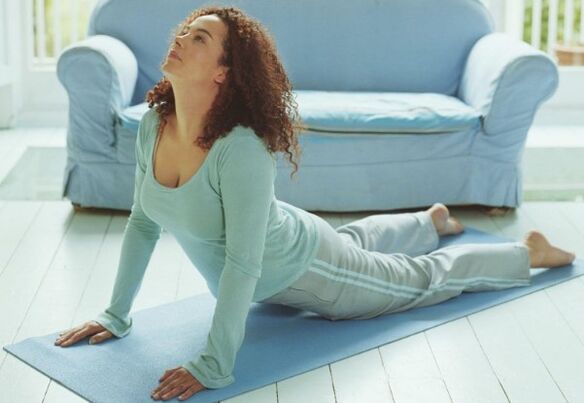Osteocartilage degeneration in the cervical vertebra is a fairly common disease in which malnutrition changes occur on the intervertebral disc between the vertebrae and the bone base in cartilage tissue. This pathology develops in many people aged 30. The symptoms of cervical osteochondrosis are diverse, so diagnosing the disease and choosing the right treatment is very difficult.

Factors that cause disease appearance
Cervical osteochondrosis can develop under the influence of the following factors:
- Too much weight;
- Seated work, no activity;
- Previous injuries to the spine;
- Mental disorders, stressful over-tension;
- Poor physical training;
- The curvature of the spine, scoliosis, improper posture;
- The wrong position of the body has become a habit;
- Neck tension, return during surgery;
- tilt at the genetic level;
- Body stress is unusual and the activity increases;
- Have a meal.
The cervical region of the spine is subjected to increased loading, and the cervical muscles try to lead to equilibrium during the influence of the above sources. This causes the appearance of muscle spasms, thus violating the blood transport of the entire body. As a result, the formation of anatomical lesions was noted.
The degree of osteochondrosis
During the development of cervical bone cartilage, the disk between the vertebrae is weakened, and therefore, the structure of the intervertebral disc, vertebrae, and joint bone changes. The first-level disease is almost asymptomatic because the cartilage changes have just begun. In this case, one complains about the appearance:
- Headache;
- Neck, arms, shoulder discomfort;
- A small amount of restriction on neck movement;
- Reduce visual function in the short term;
- Reduce sensitivity in the clavicle area.
The second stage is sometimes accompanied by the appearance of a small vertebrae hernia and the narrowing of the cracks between the vertebrae. Due to the invasion of nerve receptors, there is a little pain during the exercise. In the context of a second degree disease, patients noticed appearance:
- Pain syndrome on the neck, head movement curved;
- Loss of sensitivity to skin in the arms and shoulder areas;
- Reduce visual function;
- Ring in my ears;
- Numbness on the face and neck;
- Weakness in hands;
- The pain of shooting the shoulder;
- Diseases of sleep function.

Treatment of osteochondrosis in the third degree of cervical area is very difficult. Currently, hernia develops, spinal deformation, position changes, dislocations in ridge elements. This stage of the disease is accompanied by:
- Significant pain in the neck, myocardium, and collar areas;
- lack of skin sensitivity on the head, arms and shoulders;
- Paralyzed hands;
- lack of tendon reflex;
- The formation of hernia in cervical vertebrae.
During the fourth (final) phase, an intensification of signs was noted.
symptom
The signs of neck disease differ significantly from the symptoms of osteochondrosis in another area of the vertebrae.As the cervical spine approaches, the nerve roots and spinal cord are pinched.This leads to the emergence of this sign:
- Pain syndrome is locally located on the neck, nape, shoulders, arms and legs. When the nerve receptor is added, the feeling in the shoulder area is uncomfortable and the back of the head begins to rebuild the hands. Due to cervical cramps, blood circulation is disturbed.
- Noting that the occurrence of upper limb weakness is associated with impairment of root function, which helps incorporating motor nerves that reconstruct muscle tissue.
- Due to its reduced sensitivity, the upper limbs were reconstructed, violating the roots of the sensitive nerve ends.
- When you turn to your head, you will feel a painful feeling and you can hear a crunch. This is explained by damage to the small joints in the cervical area, where the level of the intervertebral disc is reduced.
- Patients complain about the emergence of insufficient strength, fatigue, dizziness and coordination disorders. Due to the displacement of spinal elements, the vertebral artery is squeezed. Therefore, blood circulation worsens, resulting in a weakening of blood supply to the occipital and cerebellum.
- Noting the emergence of problems, loss of sensitivity in language.
The symptoms of cervical osteochondrosis in women are no different from those in men. Women who have been diagnosed with the disease have already been 45 years of age and older, with numbness and tingling in their upper limbs in their dreams.
What are the risks of osteochondrosis in the cervical area?
This disease can damage the entire body. The neck is located in a large number of arteries, nerve receptors, and blood vessels that supply the brain through these arteries. Even if a minor illness occurs, they will be squeezed.This has caused problems in the brain's blood supply.As a result, migraine, the formation of heart rhythm disorders, the emergence of respiratory and visual functions were also impaired.
In the context of cervical osteocartilage, this disease may develop:
- pathology of the brain;
- Arterial vascular syndrome in the spine;
- Spine stroke.
The most serious complication is the death of the patient, which can occur when the spinal tube is squeezed. The symptoms and treatment of cervical osteochondrosis are due to the stage of the disease.
The therapeutic effect of cervical osteochondrosis
Regardless of the gender of the patient, treatment of cervical vertebrae is prescribed. The treatment is performed at several stages:
- Eliminate manifestations of pain.
- Eliminate swelling.
- Blood circulation to specification.
- Fix the muscles on the back, abdominal pressure, chest.
- Improve nutritional quality and tissue spine regeneration.
If the signs of this disease are found to be even trivial, you need to consult an expert. Using this pathology, a comprehensive approach is used that requires examination of surgeons, neuropathologists, physical therapists and manual therapists.
For therapeutic purposes, use of cervical osteochondrosis, medication, physical therapy, massage of neck straps and physical therapy exercise backgrounds, as it is very effective in this case.
drug
When the osteocartilage degeneration in the neck is detected, they are prescribed:
- Preparation to eliminate muscle cramps;
- Vitamin tools improve metabolic processes in the central nervous system;
- Drugs in the NSAID group relieve pain and eliminate inflammatory processes and swelling;
- The joints of the joint help restore the cartilage and eliminate diseases in the discs between the vertebrae.
- Drugs that are conducive to improving nutrition of affected nerve tissues and regulate the transportation of blood into the brain.
First aid to aggravate cervical bone-cartilage degeneration
Sometimes, if the pain syndrome becomes unbearable but cannot see a doctor, experts recommend taking pain medication. To promote pain, you can turn to "pepper patch", but this tool will only help for a short period of time.This patch will help heat affected areas and relieve pain for a while.To get rid of swelling, it is recommended to use herbal infusion for 3-4 days.
However, it is worth considering that recovery from cervical osteocartilage is ineffective using this method. These methods help to cope with signs of disease only in a short period of time. In order to prescribe a comprehensive treatment, you must contact the help of an expert.
Physical Therapy Procedures
As part of a complex process to improve the effect, use:
- Electrophoresis - Due to the action of electric current, the analgesic ions are penetrated into the affected area. Novacaine or lidocaine is usually used during the process.
- Laser Therapy - It has anti-inflammatory effects and improves blood circulation through the effects of light.
- Magnetic therapy - helps get rid of edema in tissues and has analgesic effects.
- Ultrasound - Helps improve metabolism, anesthesia, and eliminates inflammatory processes in affected areas.

Medical Sports
Similarly, with cervical osteochondrosis, treatment exercise will help improve good condition. It is worth noting that exercise performance should not be accompanied by pain or discomfort. Complex exercises:
- We lay on our stomachs and rested on the floor. The back should be even and the head and body should be lifted. We lingered at this position for about 2 minutes and then returned to the starting position. We perform 2-3 repetitions.
- We sank into the floor, lay on your back, and stretched out our arms along our bodies. We first turn right and then right, trying to touch the floor with our ears. We do 6-7 exercises in each direction.
- We sat on the floor. We hold our breath and lean your head forward, trying to touch our chest with it. In the exhale, we bring your head backwards. The exercise must be repeated 10-15 times.
- We sat on the floor and pressed our hands on our foreheads while we lowered your head. The exercise must be performed for about 30 seconds, repeating 2-3 times.
- Smoothly, slowly, we rotate our heads to avoid dizziness. When the head starts to get dizzy, you need to stop practicing. It is necessary to rotate 10 times to the right and then rotate to the right.
Family therapy
This therapy can only be used as part of a comprehensive treatment prescribed by the doctor.At home, you can turn to folk therapy, physical therapy, and massage.
With cervical osteochondrosis, you can use the following recipes:
- Place horseradish paper on the sludge and secure it with a bandage or fabric. The paper must be poured in with hot water and then cooled to room temperature. Such bandages are placed before bed and left until morning.
- Grind the potatoes and mix in equal proportions of honey. Apply to set up compression every 7 days.
- To relieve pain, warming will help through mustard, a bag of sand, pepper, etc.

Before using all funds, it is recommended to seek consultation from your doctor.
massage
Rehabilitation massage can be performed at home. You need to start a huge area of physical health and gradually move to the affected area. The individual characteristics of the patient (the degree of neglect of the disease) should be considered, and massage complexes should be chosen. Massage should be performed by the patient, and placed horizontally on the floor. You need to put your palm on your forehead and my chin is protruding toward my chest. The muscles in the neck should be relaxed.
Massage as follows:
- First, we use a stroking exercise massage tie.
- Then go to squeeze. To do this, place your hands around your neck and move along your spine. Likewise, this technique can be used when massaging shoulder orientation.
- To warm up the neck muscles, we rub it. This will help the body relax and improve blood circulation. You need to use circular motion to move from the bone along the skull.
- The last action is vibrations due to swaying and concussion.
Preventive Action
To prevent the development of cervical osteochondrosis, it is recommended to use:
- Exercise (ideal is to visit the pool).
- Enter products from products rich in calcium and magnesium.
- I have to wash several times during the day, especially when I’m busy at work.
- Replace pillows (low price) and mattresses (it's hard for you to need). Follow your neck in a dream: the neck should be bent at least 15 degrees.
- Take a hot shower for at least 10 minutes throughout the day.
- People who exercise are not welcome and doctors recommend taking part in the yoga section regularly.
- Do not participate in the simulator as this may cause the wellbore to deteriorate.


























































































